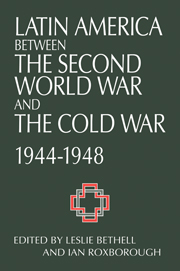Book contents
- Frontmatter
- Contents
- List of contributors
- Preface
- Introduction: The postwar conjuncture in Latin America: democracy, labor, and the Left
- 1 Brazil
- 2 Chile
- 3 Argentina
- 4 Bolivia
- 5 Venezuela
- 6 Peru
- 7 Mexico
- 8 Cuba
- 9 Nicaragua
- 10 Costa Rica
- 11 Guatemala
- Conclusion: The postwar conjuncture in Latin America and its consequences
- Index
Conclusion: The postwar conjuncture in Latin America and its consequences
Published online by Cambridge University Press: 04 May 2010
- Frontmatter
- Contents
- List of contributors
- Preface
- Introduction: The postwar conjuncture in Latin America: democracy, labor, and the Left
- 1 Brazil
- 2 Chile
- 3 Argentina
- 4 Bolivia
- 5 Venezuela
- 6 Peru
- 7 Mexico
- 8 Cuba
- 9 Nicaragua
- 10 Costa Rica
- 11 Guatemala
- Conclusion: The postwar conjuncture in Latin America and its consequences
- Index
Summary
The period between the final stages of the Second World War and the beginnings of the Cold War, that is to say, the years 1944-5 to 1947-8, constitute an important, but neglected, conjuncture in the history of Latin America in the twentieth century. Notwithstanding the region's great political, social, and economic diversity, ruling groups in the majority of the twenty Latin American republics experienced, confronted, and contained during this period significant and strikingly similar challenges from below. The nature and, more important, the outcome of the 1944-8 conjuncture established the institutional and ideological framework for the political, social, and economic development of Latin America during the following three decades (until, that is, the breakdown of the postwar “model” in the 1980s).
The final year of the war and the year immediately following the end of the war witnessed, more particularly in those countries living under a dictatorship or a narrowly oligarchic regime, a process of liberalization and democratization prompted mainly by middle-class and student groups, but with a degree of popular mobilization. There was almost everywhere a rapid growth of parties of the reformist Center-Left and the orthodox Marxist Left, especially Communist parties. In addition, most noticeably in those countries that already had a sizeable working class, there occurred an upsurge of labor militancy together with the political incorporation of organized labor, often for the first time.
- Type
- Chapter
- Information
- Latin America between the Second World War and the Cold WarCrisis and Containment, 1944–1948, pp. 327 - 334Publisher: Cambridge University PressPrint publication year: 1993
- 1
- Cited by



